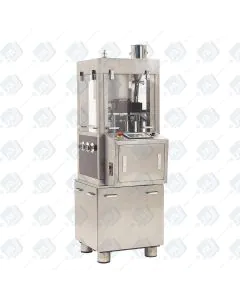RTP10i Screen Introduction
Welcome to LFA’s RTP10i Smart Screen Introduction.
When you first turn on the machine with the key, the loader screen will initiate, if you tap the screen it will pause at this section but this must be done within 3 seconds otherwise it will load the main operating system.
On the loader section, there are 3 options. Transfer, start and control panel. These are for working on the backend of the machine’s settings.
Start will initiate the main operating system, just like if you were to leave it for 3 seconds at the start.
Transfer, this is what’s used to upload new software to the tablet press. An example of this would be if a new language pack was requested on the machine, this would be how we’d upload it.
Control panel, most likely this section wouldn’t need to be used but there are options such as sound settings to adjust the volume, a password function to lock the screen and most importantly the ethernet section.
In the ethernet section, you’ll find the ip address for the machine, you’ll need this ip address when uploading new software packages to your machine through the “transfer” section.
The program that’s used to upload the software packages is called WinCC.
If the touch screen needs calibrating, this can also be done by going to the main menu, OP, then touch at the top and recalibrate and then follow the on-screen instructions.
Now if we start the main operating system, it will load up the language selection screen. As standard your RTP10i will come with English, German and Spanish, however, if you request a different language, this can be added to the machine.
On the main screen, we first have the turret speed control which can be increased or decreased with the up and down arrows.
Speed, current and pressure will display when the machine is in operation with the pressure measured in kilonewtons.
The pre-pressure thickness will show you your pre-compression thickness settings, which can be adjusted with the pre-compression knob on the side of the machine.
Main thickness is your main compression rollers current settings which can be adjusted with the main compression roller knob on the side of the machine.
Filling thickness, this shows your machines current fill depth and can be adjusted with the fill depth knob on the side.
There’s also the function to turn your machine from manual to auto. On the main screen and feed section, there’s the option to jog the machine’s turret, force feeder and vacuum, these will only work whilst the machine is set into manual mode. Whilst in auto mode you’ll be unable to use the jog functions, instead, when you press run on the main screen, the machine will simultaneously run the turret, force feeder and vacuum or dust extractor.
Now if we press on “feed” at the bottom it will take us to the Feed section, in this section we can run our force feeder and vacuum jog or we can jog them both at the same time. Again functions will only work when the machine is set to manual mode on the main screen.
The next screen is the production screen, it will display how long the machine has been running for, how many tablets it’s produced and the current pressure.
In the parameters section, it will show you, your max pressure settings, your protect pressure settings, transmission ratio and station quantity. However we don’t need to adjust the bottom 4 on this section, but the max pressure and protect pressure are there to shut down the machine in the event of an overload.
If you were to press the parameters button a second time, it would take you into the pre-defined parameters of the machine and these are not adjustable.
In the alarm section, there’s a range of alarms on the machine to protect the user and your machine, door alarms, motor alarms, pressure overload and emergency stop.
If you were to press the emergency stop button it would activate on this screen, also if we were to open a door, the alarm system would activate.
These are the main controls on the RTP10i smart screen.




